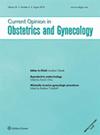Pelvic floor physical therapy in the treatment of pelvic floor dysfunction in women.
IF 2.2
4区 医学
Q2 OBSTETRICS & GYNECOLOGY
引用次数: 78
Abstract
PURPOSE OF REVIEW To describe the principles of pelvic floor physical therapy (PFPT), review the evidence for PFPT as a treatment for pelvic floor dysfunction, and summarize the current recommendations for PFPT as a first-line conservative treatment option for pelvic floor disorders. RECENT FINDINGS Pelvic floor dysfunction can cause voiding and defecation problems, pelvic organ prolapse (POP), sexual dysfunction, and pelvic pain. PFPT is a program of functional retraining to improve pelvic floor muscle strength, endurance, power, and relaxation in patients with pelvic floor dysfunction. Based on the available evidence, PFPT with or without supplemental modalities can improve or cure symptoms of urinary incontinence, POP, fecal incontinence, peripartum and postpartum pelvic floor dysfunction, and hypertonic pelvic floor disorders, including pelvic floor myofascial pain, dyspareunia, vaginismus, and vulvodynia. Currently, there is conflicting evidence regarding the effectiveness of perioperative PFPT before or after POP and urinary incontinence surgery. SUMMARY PFPT has robust evidence-based support and clear benefit as a first-line treatment for most pelvic floor disorders. Standards of PFPT treatment protocols, however, vary widely and larger well designed trials are recommended to show long-term effectiveness.盆底物理疗法在治疗女性盆底功能障碍中的应用。
综述目的:描述盆底物理治疗(PFPT)的原理,回顾PFPT作为盆底功能障碍治疗的证据,并总结PFPT作为盆底疾病一线保守治疗方案的目前推荐。盆底功能障碍可引起排便和排便问题、盆腔器官脱垂(POP)、性功能障碍和盆腔疼痛。PFPT是一项功能再训练计划,旨在改善盆底功能障碍患者的盆底肌肉力量、耐力、力量和放松。根据现有的证据,PFPT加或不加辅助方式可以改善或治愈尿失禁、POP、大便失禁、围产期和产后盆底功能障碍以及盆底肌筋膜疼痛、性交困难、阴道痉挛和外阴痛等盆底高张力疾病的症状。目前,关于围手术期PFPT在POP和尿失禁手术前后的有效性,存在相互矛盾的证据。作为大多数盆底疾病的一线治疗,ypfpt具有强有力的循证支持和明显的益处。然而,PFPT治疗方案的标准差异很大,建议进行更大规模的精心设计的试验以显示长期有效性。
本文章由计算机程序翻译,如有差异,请以英文原文为准。
求助全文
约1分钟内获得全文
求助全文
来源期刊
CiteScore
4.10
自引率
0.00%
发文量
104
审稿时长
6-12 weeks
期刊介绍:
Current Opinion in Obstetrics and Gynecology is a bimonthly publication offering a unique and wide ranging perspective on the key developments in the field. Each issue features hand-picked review articles from our team of expert editors. With eleven disciplines published across the year – including reproductive endocrinology, gynecologic cancer and fertility– every issue also contains annotated references detailing the merits of the most important papers.

 求助内容:
求助内容: 应助结果提醒方式:
应助结果提醒方式:


